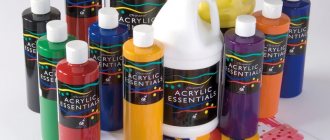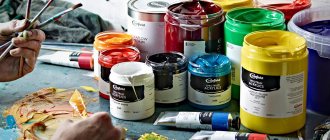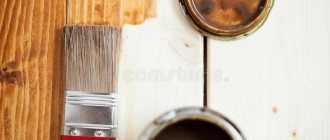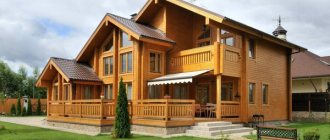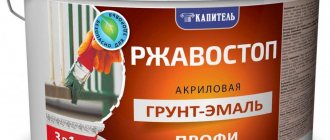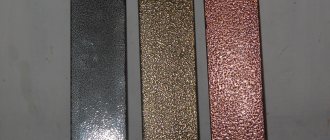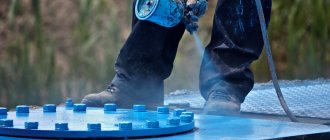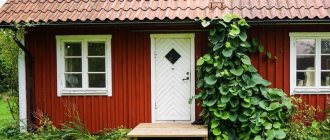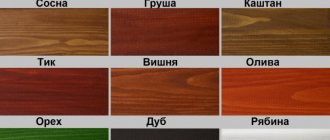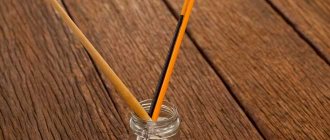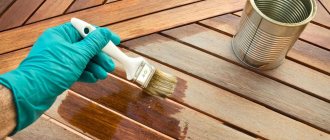How to choose the right paint for metal: tips and tricks
A good metal paint should have a thick consistency that does not leave streaks or difficult-to-remove stains. The best metal paints have a gel or semi-liquid consistency. This is very important because this paint will not run or drip from vertical surfaces. Good metal paints can also be used to protect steel structures from corrosion and surface damage caused by salt, water, sunlight and chemicals.
It is no secret that metal elements are always difficult to paint due to their physical and chemical properties. A good and inexpensive metal paint should be distinguished by correctly selected chemical components. It can be a one-component or two-component emulsion that dries quickly and contains anti-corrosion elements. The material must also be resistant to sunlight and physical impact.
On a note! Properly selected metal paint can be applied even in a thick layer. Its task is to protect the covered elements from both the internal and external parts.
Video - How to choose paint for metal and wood
Types of enamels
Paints and varnishes for woodwork are divided into 2 types:
- for outdoor work;
- for indoor work.
When painting the outside of a building, wear-resistant paints are used. They have the properties necessary to ensure that wood parts or finishes last as long as possible. Among them it is worth highlighting:
- wear resistance;
- resistance to sudden temperature changes;
- protection from insects and rodents;
- color fastness.
Voting for the best metal paint
What metal paint would you choose or recommend?
Hammerite
25.00 % ( 4 )
Alpina Direkt Auf Rost
0.00 % ( 0 )
Hammerite
6.25 % ( 1 )
ALTAX Enamel Super Durable
6.25 % ( 1 )
Tikkurila Panssarimaali
12.50 % ( 2 )
BIANCO PURO Extra Matt
0.00 % ( 0 )
Nobiles Termal 500
0.00 % ( 0 )
V33 Direct protect
0.00 % ( 0 )
Dulux Professional Diamond
0.00 % ( 0 )
Emakol Strong
0.00 % ( 0 )
Pantolac Stancolac
0.00 % ( 0 )
Hammer effect
6.25 % ( 1 )
Mixon Hamerton
0.00 % ( 0 )
Tikkurila Metallista
12.50 % ( 2 )
Śnieżka Supermal
0.00 % ( 0 )
Prestige MA – 15
25.00 % ( 4 )
Detailed review
Exterior paints
All compositions that are used for painting facades can be divided into three groups - acrylic, oil and alkyd.
Acrylic
Such paints and varnishes were able to gain great popularity and became a standard in European countries. This is an environmentally friendly building material for external processing, which is based on water, and acrylates also play the role of binding components.
Properties of the presented enamel group:
Does not have a poisonous aroma.- Allows the wood flooring to breathe without covering the pores.
- Can reliably protect against frost and moisture.
- The freshness of the range of colors will last for years (for 10 years).
This paint and varnish product is mixed with pigment. If desired, the owner can get absolutely any shade and color. But you should remember that there is a certain set of rules that should be followed when choosing paint colors for outdoor work. When working, acrylic paint will not cause any big problems, and it can be applied with a paint brush, a special roller or even a spray gun. The material dries perfectly, and you can also refresh the surface even over an old coating.
Please note that storing acrylic-type water-based paint at subzero temperatures is prohibited.
Alkyd enamels
They began to be used much earlier than acrylic ones, but they are even now popular due to their low cost. When painting, a thin film will be formed on the surface, which can repel water and increase the protection characteristics of alkyd paint. Such a coating will dry instantly, but will not have time to penetrate into the wood layers, and therefore it is short-lived. This enamel can be recommended for painting window openings, doors, and thresholds. Also, alkyd paints for exterior work will work on a perfectly dry surface, and therefore all unevenness, peeling and bubbles will inevitably be noticeable.
Oil paints
Another wear-resistant paint for exterior use is oil-based. True, it is steadily losing popularity, giving way to acrylic and alkyd compositions. Oil paints are made from drying oil - artificial or natural - and can be tinted in almost all colors.
Their loss of popularity is due to many negative characteristics:
- Toxic (strong aroma even after perfect drying).
- They take a long time to dry out.
- They are washed off only with special solvents, which are also toxic and have a strong aroma.
Now let’s take a closer look at other paints for interior work.
Interior paints
Most often, wooden floors are painted inside a living space. The following paints and varnishes are used for this:
- Alkyd.
- Water-dispersed.
- Polyurethane.
- Rubber.
- Wear-resistant, especially for wooden floors.
They all have different characteristics.
Water-dispersed acrylic compositions
This is the most popular type of paint and varnish material, and its advantages cannot be disputed:
- Environmental friendliness of the material.
- Resistance to mechanical impacts.
- Resistance to temperature changes.
- Resistant to fading.
- Provides durable and flexible floor covering.
When applying layers, you can only get a matte surface that will not hide the wood texture.
You should buy special paint for the floor surface, because in the process of creating it the following important different points will be taken into account:
- Light stability.
- Resistant to moisture.
- Wear resistance.
- Strength.
- Long service life (manufacturer provides a 10-year warranty).
- Easy to use.
- Extensive color palette.
All characteristics will be inherent in multi-tested acrylic dispersion paint for wood, which can be used both outside and inside. Such compositions are made from synthetic binders, the basis of which is acrylic emulsion. This type of paint and varnish is very popular because it is easy and simple to work with. In other words, wood and acrylic are simply made for each other.
Alkyd enamels
Wear-resistant paint for interior work – alkyd. These types of paints are made from similar components, and they differ only in the base (in this case, alkyd types of resins are used). But this is enough for their characteristics to differ from each other.
Advantages of alkyd enamels:
- The coating is very reliable.
- Brightness and consistency of color gamut.
- Resistant to water and sudden temperature changes.
- Effective protection against rotting.
- Drying speed.
Most qualified craftsmen will give preference to this paint and varnish product, and at the same time it will not be without certain disadvantages. This is an unpleasant aroma, flammability and pungent odor, lack of resistance to chemical influences. Most often, such properties prevent its distribution on the market.
Polyurethane paints
Such polyurethane products have become a modern type of interior finishing for floors and stairs. Polyurethane enamels have many advantages:
Excellent degree of adhesion.- Instant drying.
- Formation of a wear-resistant and durable coating.
- High resistance to water and various chemicals.
- Resistance to temperature changes.
Due to its mechanical stability, polyurethane enamels are suitable for finishing wood floors. Such paints cannot be classified as budget paints, but the high cost will be justified by the long service life.
Wear-resistant enamel for wooden floors
Such a paint and varnish material can be recognized as ideal by studying its technical characteristics:
- High degree of resistance to mechanical loads.
- Abrasion resistance (only 4% of the coating is erased during use over 10 years).
- Excellent hygroscopicity.
- Easy to apply the product to the floor surface.
Wear-resistant enamel for wooden floors will not peel off or fade, and will retain its beautiful appearance for a long time. The disadvantage of such paints is flammability. Enamel can be easily flammable, and in addition, it is toxic until it dries perfectly and has a pungent, pungent aroma. When staining the extracted harmful substances, it takes an extremely long time. Complete drying takes a week, and therefore not everyone will decide to buy such a product.
Rubber paints
They are a big breakthrough in the floor coating industry. They will combine all the properties that consumers require:
- Water resistance.
- Environmentally friendly.
- Low cost.
- Strength.
- Drying speed.
- Elasticity.
- Small expense.
This type of flooring composition has gained great popularity among consumers. Rubber paint for wood has proven itself especially excellent because it allows the treatment material to breathe.
How to choose the right composition
Two-component paints and varnishes are selected taking into account the following factors:
- surface to be painted (metal, concrete or wood);
- operating conditions (high humidity, exposure to adverse weather conditions);
- financial possibilities (acrylic ones are relatively cheaper than epoxy ones);
- based on the desired color of the coating (some paintwork materials are tinted to the desired shade).
Special preparation of metal products before painting
Initially, primary processing of metal surfaces is carried out, and only then paint and varnish material is applied. If forged products have been under the direct influence of environmental factors for a long time, then due attention will have to be paid to their pre-treatment. Thus, it will be necessary to remove the paint that has already peeled off, as well as get rid of the loose layer of rust. All this can be done with coarse sandpaper, a wire brush or a sander. In cases where there are quite a lot of metal products or elements, a sandblasting machine is used.
Advantages
The advantages of water-based enamel for wood are as follows:
- harmlessness (dries quickly, only water evaporates);
- fire safety;
- ease of operation;
- has a significant service life (10 years or more);
- water resistance;
- This wood enamel is odorless (this advantage is especially evident when covering large surfaces or working for long periods of time during the day).
The main disadvantage of this paint is the requirements for storage conditions. Water-dispersion paints must be stored at a temperature not lower than 0 ºС.
Main characteristics
Two-component epoxy paint for metal has many advantages:
- Durable coating of the painted surface
- Elasticity of paint coating
- Waterproof
- Resistance to various types of mechanical damage
- Resistance to aggressive environments
- Non-flammability
- Strong adhesion to different types of metal surfaces
- Possibility of single layer application
- Variety of colors and coatings available
The film obtained by treating the surface of products with two-component epoxy-based paint is very durable; even single-layer painting provides sufficient surface protection. The surface of products painted with EP paints becomes inaccessible to moisture penetration, which is used for waterproofing purposes. The resistance of the paint film to various external chemical influences (alkalies, acids, salts and fuels and lubricants) provides good anti-corrosion protection, and therefore increases the service life of products.
Under the influence of mechanical loads, the paint film tends to stretch, but is not damaged. Then it recovers from deformation. Since these paints are non-flammable, they are widely used in painting electrical products, which prevents damage to equipment due to overheating.
The main disadvantage of two-component epoxy materials is instability when exposed to ultraviolet rays, and the rather long process of complete drying of the paint.
Flow rate
The consumption rate is affected by the characteristics of the surface being painted. Typically, product packaging indicates consumption per square meter. In this case, you need to take into account:
- roughness, degree of preparedness of the wall;
- repeated or primary painting;
- features of the type of wood, type of material (chipboard, fiberboard, plywood, board);
- method of application: a more economical option - spray gun and roller;
- quality, brand, composition - these indicators are determined by the number of layers, usually two are enough, but when using cheap material the number increases to 15%.
Consumption can be reduced slightly if you apply the first layer with a more liquid solution. According to GOST, the consumption rates for acrylic paint look like this: 0.25 kg for one layer per 1 m2, 0.15 kg for two layers. When applying a second coat, consumption is reduced by at least 30%. When reapplied, the composition is diluted by 5%, no more.
Dry residue is the mass fraction of non-volatile components of substances. It shows the content of fillers, pigments, additives, which, after drying, form a paint film on the surface. The thicker this film is, the longer the created coating will last . For high-quality brands, the amount of dry residue is no more than 20% .
Painting with blacksmith's CM
The composition is applied to red rust spots, over the old layer of paint. It interacts poorly with a base previously painted with oil CM, bitumen and powder paint.
Painting is not carried out without surface preparation:
- surface treatment with solvents (solvent, white spirit);
- attention is paid to removing grease. You may need to repeat washing the base up to three times;
- wipe the area to be painted with acetone;
- use a paper napkin to check the absence of oil stains on the surface;
- areas with a shiny surface are cleaned. Use sandpaper and a metal brush. This increases the tenacity of the CM with the base.
On a metal base:
- the old layer of paintwork, especially peeled pieces, is removed with a metal brush;
- the same tool removes loose rust;
- the cleaned surface is washed with detergent, the powder is thoroughly washed off, and dried;
- aluminum base, stainless steel and galvanized steel are coated with a metal primer; wood – with an acrylic primer (the penetration of CM into the pores of the wood is reduced). Manufacturers have developed compositions that combine decorative characteristics and a primer. For complex shaped metal products, an enamel primer with a rust converter is recommended. All characteristics are indicated by the manufacturer on the container or in the instructions for the composition.
Depending on the area of application of CM, on what kind of painting tool the worker has, one or another painting technology is used. It is recommended to work with forge paint at air temperatures from 10 to 25 degrees above zero and humidity up to 85%.
Modifications of the dye have been developed that are used in any season; the permissible temperature conditions for application are from -30 o C to +40 o C. The composition is applied with a thickness of 100 microns. If the indicator is lower, the protective qualities will decrease. The material is applied by brush, roller, aerosol, mechanical and pneumatic spray.
A two- or three-layer coating is done with a brush. Attention is paid to corners and edges. The waiting time for each layer to dry is 20 minutes. If the configuration of the object is complex, then it is recommended to cover the fourth layer. Select a brush with natural bristles.
Large surfaces are painted with a roller (hard-to-reach places are painted with a brush). A tool with a short-haired wool roller is selected.
You can eliminate defects and paint a small object with an aerosol can. The paint is sprayed at a distance of 20 cm in 3-4 layers.
Before pumping the CM into a pneumatic sprayer, it is diluted with a solvent recommended by the manufacturer of the specific paint purchased. The solvent is introduced into the composition in the proportion: 2:1. If the composition drains, the proportion of solvent decreases. Allow 3 minutes for the first coating layer to dry. After a 15 minute interval, the second and third layers are applied. For an airless sprayer, the paintwork is diluted in the ratio: 9:1. The painting algorithm is the same as with a pneumatic sprayer.
The painted item is ready for use after 12 hours. Forge paint on metal protects the base from rust.
If painting is carried out indoors, ventilation must be provided. After drying, the coating becomes safe for humans.
The remaining material is left in a hermetically sealed container. The composition is stored and transported at a temperature from +30 o C to -40 o C; the sun's rays should not fall on the storage site; containers with the material are not located next to heating devices.
Application of wood imitation paint
Features of using hammer paint on metal
Features of choosing paint for metal products
Application area
The widespread use of two-component epoxy-based paints in everyday life and industry is due to their high technical characteristics. They are used in:
- Household painting of metal surfaces
- Painting car parts
- As an anti-corrosion protection for radiators and metal parts in rooms with high humidity levels
- On oil pipelines, gas pipelines
- For painting oil and fuel storage tanks
Two-component epoxy-based paint for metal is used not only as a finishing paint and varnish. It is often used as a primer for additional protection and leveling of the surface of metal products.
Application technology
Before starting work on applying epoxy coatings to the surface to be painted, it is necessary to mix the base and hardener very thoroughly. A prerequisite is also strict adherence to the proportions of the components. This will allow you to obtain the required quality of coating and avoid problems with paint defects. The entire area to be painted is well cleaned of loose rust, various grease deposits, dust and dirt.
Painting can be done manually (brushes, paint rollers) or with a power tool (pneumatic or airless spray).
It is not advisable to use solvents to thin epoxy paint, as they significantly reduce the moisture resistance and strength of the paintwork. If there is a need to dilute thickened EPA, then this must be done carefully, selecting the proportions of paint and solvent.
Important. Be sure to follow safety precautions.
Since the chemical reaction that occurs as a result of combining the base and hardener generates a large amount of heat, when working with epoxy paints it is necessary to follow basic safety rules:
- Be sure to use special clothing and personal protective equipment;
- If work takes place in a confined space, then sufficient ventilation is required;
- To mix components, use only special tools and appropriate containers;
- If paint comes into contact with skin, remove drops before they dry;
There are many varieties of epoxy paints for metal. The price for them often depends not only on the specific type, but also on the manufacturer. It is better to carefully analyze the purpose of using paintwork materials and, depending on this, choose the necessary paint.
Criterias of choice
What to look for when purchasing? There are many varieties, and the main thing is to avoid mistakes when choosing. At the very beginning, it is advisable to familiarize yourself with the features of various types, their scope of application, find the best manufacturers and review popular formulations, study ratings and reviews. It’s worth asking yourself the following questions:
- What surface is to be coated? There are universal options that are suitable for both external and internal work; they can be used for concrete and metal surfaces, ceilings, walls, floors and so on. But if you will be working with a specific material, then it is best to choose a specialized model, since they all have different heat resistance, resistance to high concentrations of sunlight, etc.
- A certain surface requires a specific enamel paint. Each base absorbs the substance in its own way. If you make a mistake when choosing, the product will not be evenly distributed over the surface and will quickly fade. Therefore, before starting work, you need to understand how the paint will react to the base you have chosen.
- Maximum drying time. There are options that dry within one hour, and sometimes you have to wait about a day. This point should be taken into account, since there are cases when the premises need to be used as soon as possible after the renovation is completed. The ambient temperature is also important: the higher it is, the faster final drying occurs. In the cold season and in rainy weather, the drying process is delayed for weeks, so it is very important to choose the optimal time period for a specific type of work. Moreover, if the paint has a pungent odor, then it is worth ventilating the room for a long time.
- Decide on the structure of the paint. The product comes in such a variety of colors and shades that you can get lost. According to buyers, certain shades may not always be combined with the external structure. Today, stores offer matte, semi-gloss, rich matte and glossy enamel structures. First, you should decide what effect you expect, and then purchase the product.
- Estimated number of layers applied. This indicator affects the volume of purchased funds. To make the surface uniform and rich, you need to go over it at least three times with enamel. But it all depends on the chemical composition of the product.
Once you have decided which product is best to buy, go to the store and carefully look at the label and the condition of the container with the material. It must be completely unharmed, without visible mechanical damage, such as abrasions, scratches, dents, punctures, and so on. It is worth keeping in mind that if the seal of the can is broken, the paint will quickly lose its original properties and dry out.
Particular attention must be paid to the expiration date. The product must be used until it runs out. Do not leave open goods for a long time. No matter how well you close it, you will still not be able to preserve the original qualities. Also try to find the GOST sign on the label.
If you have a question about where to buy a product, give preference to specialized stores that have proven themselves on the positive side and sell only high-quality products. You should not buy goods second-hand at the market. This could result in loss of money. You can order goods online from an online store, but often you may not receive what you expected. Which company's products are better depends on the buyer's preferences.
Terms of use
When performing work, you should follow the useful recommendations from the manufacturer. When working with aerosol materials, have a respirator, gloves, and safety glasses with you. For full compliance with safety regulations, work overalls. The room should be well ventilated. Prepare the surface in advance. The old layer is removed before the new one, all irregularities are eliminated.
With all the diversity in the range of modern finishing materials, epoxy paint for metal does not lose its relevance today. Possessing excellent protective qualities and good appearance, it is often indispensable for industrial and individual use.
Epoxy resins, on the basis of which modern epoxy paints are made, began to be used in many areas of life quite a long time ago. With the development of technology, their composition has changed, technical qualities have improved, and the scope of application has expanded. Now they are one of the most popular paints and varnishes. Epoxy paint for metal is available in several types.
Oily
The main components of the compositions are natural oils and drying oil. The product is also available in cans, but does not need to be diluted before use. Such compositions are often used for painting indoor forged products.
| pros | Minuses |
|
|
Anti-corrosion
These compounds are designed specifically to protect metal from corrosion. Also available in cans. Contains synthetic resins and anti-corrosion pigments.
| pros | Minuses |
|
|
Acrylic
Acrylic paints are produced on the basis of polyacrylates. They are also available in cans. They are very durable, so they will retain their protective properties for a long time without updating the paint layer.
| pros | Minuses |
|
|
Flaws
If we point out the disadvantages of this paint, we can note the following:
- When tinting with dye, it is necessary to take into account the volume of paint for the entire area of the surface being treated, since when tinting the subsequent volume it will be very difficult to get the desired shade.
- Paint drips that form during its application must be removed immediately, otherwise a special solvent will have to be used.
- You should not leave a container of paint open, as it dries very quickly and may become unusable.
